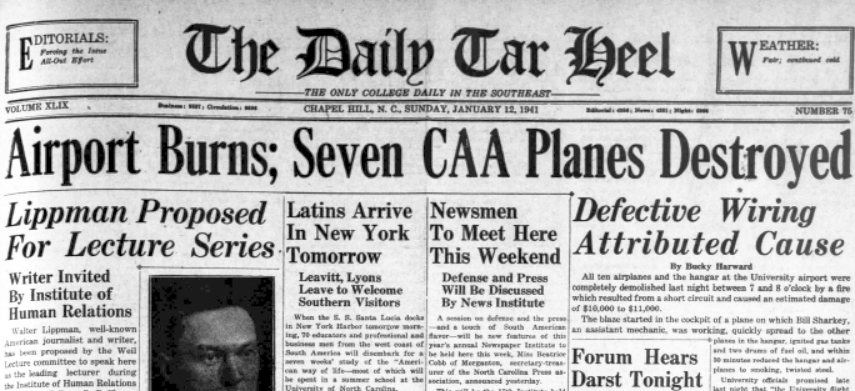From the Daily Tar Heel, January 12, 1941, via Digital NC / North Carolina Newspapers:
Airport Burns; Seven CAA Planes Destroyed
Defective Wiring Attributed Cause
By Bucky Harward
All ten airplanes and the hangar at the University airport were completely demolished last night between 7 and 8 o’clock by a fire which resulted from a short circuit and caused an estimated damage of $10,000 to $11,000.
The blaze started in the cockpit of a plane on which Bill Sharkey, an assistant mechanic, was working, quickly spread to the other planes in the hangar, ignited gas tanks and two drums of fuel oil, and within 30 minutes reduced the hangar and airplanes to smoking, twisted steel.
University officials promised last night that “the University flight training program will be resumed as soon as possible.”
Entirely alone at the airport, Sharkey, 18-year-old son of an instructor, was removing the gas tank from one of the new Piper Cubs. He deposited an electric droplight, connected by an extension cord to the wall of the hangar, on the cockpit seat from which the cushions had been removed.
Fire Starts
While working on the engine at the front of the ship, he noticed the reflections of flames on the wall of the hangar. Seeing flames spreading from the cockpit to the right wing and realizing that the highly inflammable fabric was burning too fast to use any of the available chemical extinguishers, he ran to remove the plane nearest the door 20 feet outside the hanger.
By the time he returned to the remove the first plane which now had space to reach the door, the flame had spread over its fuselage and wings so that it could not be gripped. Another of the closely-group ships had caught fire which fed rapidly on the tinder-like fabric.
Seeing that nothing else could possibly be done in the hangar, he ran out to find that the plane removed had either caught fire from sparks or the intense heat. The gas drained from the first plane [then] exploded within the hangar and the other tanks followed rapidly. While the explosions were still occurring, Sharkey phoned for the fire department from the office shack on the side of the hangar and began to drag out the parachutes.
Instructor Jesse Lassiter arrived and started to help him. Remembering that highly explosive acetylene tanks were just inside the hangar, Sharkey shouted a warning and the two ran a safe distance. Probably because of a cracked valve, the acetylene tanks failed to ignite, but the plane tanks were still exploding. The instructor and assistant had to stand by “while everything just went.”
Spectators began to gather and stayed to watch the fire die down. Since no water was available for fighting the blaze and the fire was too great to be extinguished by chemicals, the town fire department did not answer the call.
Seven of the ten planes were Piper Cub trainers belonging to the University. Three had been purchased only six weeks ago. The remaining three planes were privately owned. The University planes [that] one of those students owned are insured. Absolutely nothing is salvagable except possibly the motor of the plane removed.
Nothing remains of the hangar but the melted beams of the steel framework and the concrete foundation. The wooden weather boarding collapsed even before the composition roof caved in.
Several other items were lost in the fire. Two 50-gallon drums of fuel oil and the acetylene tanks aided the blaze. A $350 transit and other surveying instructions, a great number of WPA tools, grading notes and the original field drawing, all of which are being used in the recently begun $208,000 WPA project, were totally destroyed. Other equipment and mechanics’ tools were lost tool. Grading plans and the log books of several instructors were demolished, but had already been transcribed for the most part.
The small house directly behind the hangar contained student flight statistics and escaped the flames. As an extra precaution, the valuable records were brought into town and several men with fire extinguishers were stationed all last night to prevent flying sparks from igniting the house.
University officials did not give an accurate estimate of the damage last night.
Thirty-four of the 38 students enrolled in the fall training were supposed to complete the course by February 1 when 50 others are scheduled to begin flying.
